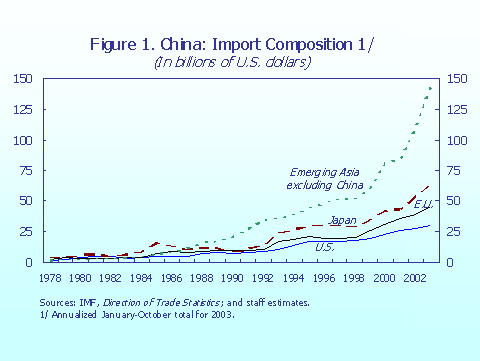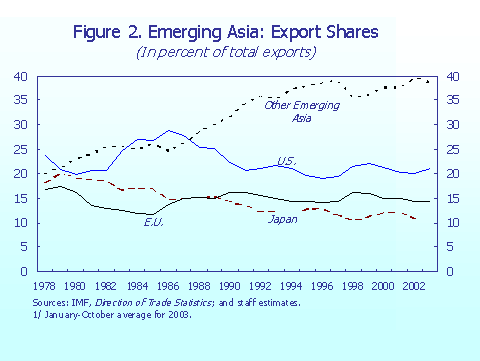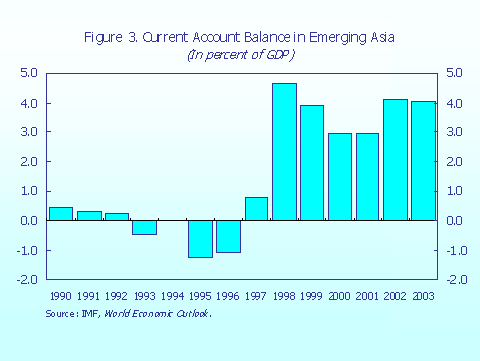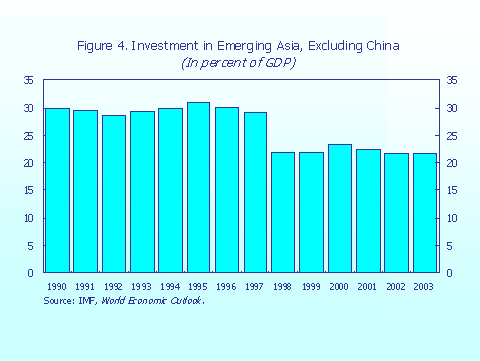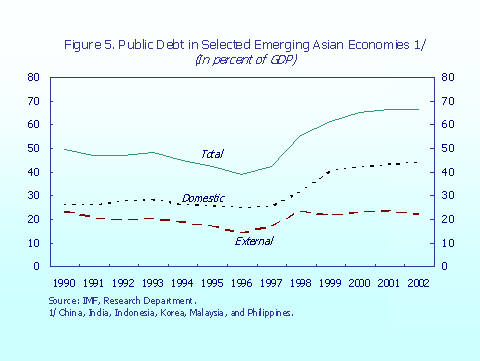What Lies Ahead for Asia's Emerging Markets? Speech by David Burton, Director of the Asia and Pacific Department, IMF
March 23, 2004
Speech by David Burton
Director of the Asia and Pacific Department
International Monetary Fund
For the 2004 Credit Suisse-First Boston Asian Investment Conference
Hong Kong, March 23, 2004
1. Ladies and Gentlemen, it is an honor to participate in this important conference and, as always, a pleasure to be in the city that epitomizes the vitality of this region. Today, I would like to talk about the economic outlook for Asia, focusing mainly on the emerging market economies, and to discuss some of the challenges the region needs to meet to fulfill its enormous potential. Although the focus of my remarks is on Asia's future, a brief look at its recent performance is necessary to set the stage.
2. Asia showed considerable resilience last year. The SARS outbreak and geopolitical uncertainties slowed the momentum in most economies, but only temporarily. Supportive macroeconomic policies and the recovery of the global economy helped the region to bounce back in the second half of the year. Propelled by a resurgence of domestic demand and the highest export growth in nearly three years, non-Japan Asia was—once again—the fastest growing region in the world.
3. Let me draw your attention to four features of this impressive economic performance that have to be kept in mind in assessing the near-term outlook and policy challenges for Emerging Asia—my short hand for Asia's emerging market economies.
- First, China and the rest of the region are becoming increasingly interdependent. This is happening in the broader context of China's emergence as a major trading power—with 6 percent of world trade, China is now the fourth largest trading nation. While China's imports from all regions have been growing, those from the rest of Asia have been expanding particularly rapidly (Chart 1). This, of course, mainly reflects China's rising role as a processing hub for exports from the region. However, a significant part of the increase in China's imports has also gone to meet growing domestic demand for consumption and investment goods. Thus, economic performance in China now has significant spillover effects on the rest of the region. Indeed, China's fast growth has supported the recent recoveries in neighboring countries.
- Second, in spite of surging intra-regional trade (not least that involving China) Emerging Asia continues to depend heavily on economic developments in the rest of the world. Exports between countries in the region have risen steadily from about 20 percent of total exports in the late 1970s to about 40 percent in 2002 (Chart 2). However, perhaps only about half of this trade is going to meet intra-regional final demand. Thus, the bulk of the exports of Asian countries is still linked to economic activity outside the region.
- Third, the central role of external demand has been reflected in a sustained current account surplus for the region (Chart 3). This was on the order of 4 percent of Emerging Asia's GDP in 2003, or about US$145 billion. On the additional strength of a marked pickup in capital inflows, official reserves in Emerging Asia have surged to about US$1.2 trillion, chalking up an increase of US$270 billion in 2003 alone. The magnitude of these developments raises questions about both their global implications and domestic sustainability.
- Fourth, the cyclical upswing in Emerging Asia has so far not been accompanied by strong domestic investment, with China a notable exception. (Chart 4.) This is, of course, the mirror image of the strong current accounts. Subdued investment has reflected the necessary adjustment to the unsustainable boom of the mid 1990s, as well as uncertainties associated with the ongoing restructuring of production within the region. But it has also reflected lingering structural weaknesses and—as such—has implications for the unfinished reform agenda.
4. Turning now to the economic outlook, the near-term prospects for the region appear bright. The recovery in the global economy, although still uneven, is strengthening and broadening. In particular, growth is rapid in the United States; it is picking up in Japan, led by investment and exports; and, although still lagging, it shows signs of revival in the euro area as well. Overall, the IMF's forecast for global growth will likely be revised upward in the forthcoming World Economic Outlook.
5. Against this general background, we expect growth for Emerging Asia to be over 7 percent in 2004, broadly the same as last year. This incorporates a modest slowdown in growth in China, to perhaps around 8½ percent, as a tighter monetary stance cools investment activity. Significant pickups in growth are foreseen for most other countries in the region on the back of a strong export expansion. Moreover, the balance of near-term risks may even be on the upside, with the United States economy rebounding, global trade rising sharply, and the strong recovery in the electronics sector.
6. Looking further ahead, while there are reasons to be optimistic, important challenges and risks are present. The baseline scenario for 2005 has growth in the global economy and that in Asia slowing marginally, as expansion in some key economies reverts closer to potential. However, there are challenges to sustaining world growth. These include: making progress with an orderly resolution of global current account imbalances; managing the transition to higher interest rates in industrial countries and a likely rise in spreads on emerging market debt; and addressing difficult fiscal situations in many industrial countries and some emerging market ones, including here in Asia. Each of these challenges—if not addressed properly—carries a risk of weakening the global recovery on which Asia is dependent.
7. Given the growing regional interdependence mentioned earlier, downside risks also arise from the possibility of a much sharper slowdown in China than foreseen in the baseline. Our central scenario is for a soft landing, but a more abrupt slowdown remains a possibility if China is not successful in striking the right balance between preventing generalized overheating and avoiding a large decline in investment. It is perhaps a reflection of how dismal our "dismal science" is—or perhaps just a reflection of human nature—that the list of downside risks usually tends to be longer than the list of possible surprises on the upside.
8. Be that as it may, it should not be forgotten that Asia's ability to cope with external shocks has come a long way since the Asia crisis. Some observers have expressed concerns that the region is already increasing its exposure to an abrupt reversal of capital flows, drawing parallels with the early 1990s. However, most countries in Asia now have far greater resilience than then. Key strengths include ample, or more than ample, official reserves in many countries, more flexible exchange rates, and stronger bank and corporate balance sheets. This said, Asia is not yet "bullet proof", and important policy tasks to increase its resilience remain.
9. I will now discuss four areas where policymakers need to focus in the period ahead to strengthen prospects for sustained growth:
- First, exchange rate policy, including in light of global current account imbalances;
- Second, the need for further progress with structural reforms;
- Third, ensuring that public debt levels are reduced;
- And, lastly, regional economic cooperation.
10. Before elaborating on these issues, let me note that there is, of course, never an easy time to step up reform efforts. This often involves tackling vested interests and can be politically difficult. But there are moments when doing so is significantly easier than others. The world economy is now on the upswing, and the immediate outlook for Emerging Asia is brighter than for some time. Advantage should be taken of these "good times" to prepare for the day when they, at least temporarily, come to an end, as good times always do.
11. The large current account imbalances in the world economy are a concern because of the risk of disorderly adjustment that could disrupt global growth. Asia, with its sizable current account surpluses, is a significant part of this pattern of imbalances—although the current account deficit in the United States is, of course, the most prominent element. And because of its dependence on the strength of the global economy, Asia has much to gain from an orderly resolution of this problem. What is required is a cooperative approach with each region playing its part and with the burden of adjustment fairly shared. This strategy must involve three main elements:
- First, a credible framework to restore fiscal balance in the United States;
- Second, stepped-up structural reforms in the euro area and Japan to raise their productive potential;
- And third, greater use of exchange rate flexibility, together with further reforms to bolster domestic demand, in those countries—notably in Asia—that have experienced a rapid accumulation of foreign exchange reserves,.
12. Contributing to a global adjustment, however, is not the only, or indeed even the main, reason for advocating greater exchange rate flexibility in Asia. Increased flexibility would be beneficial in several countries from a narrower domestic perspective. For example, it would allow monetary policy to be geared more toward domestic stabilization. This is especially important at a time when inflationary pressures could pick up. Greater exchange rate flexibility could also help reduce vulnerability to external shocks. And it would permit countries with low inflation greater latitude in responding to the unwinding of the easing cycle in advanced economies. Exchange rate flexibility would also allow countries that have been accumulating reserves to avoid further costs associated with the sterilized intervention otherwise needed to control liquidity growth. Of course, exchange rate policies need to be tailored to individual country circumstances, with pegged rates more suitable for small, very open economies.
13. Let me make a short digression on China's and Japan's exchange rate policies. There is a view that the inflexibility of exchange rates in the region—especially in China—reflects a deliberate development strategy centered on export-led growth and an undervalued exchange rate. Some observers have also argued that the accumulation in reserves may be sustainable for some time, especially as the large supply of low-wage labor in China will keep inflationary pressures in check. It is certainly true that reluctance to see exchange rates strengthen against the dollar stems in part from concerns about the implications for growth and job creation. At the same time, it should be remembered that China stuck to its peg to the dollar throughout the Asia crisis while other countries in the region were depreciating sharply. Also, China maintained subsequently the present peg as the dollar strengthened through 2001. So China's exchange rate policy, in my view, at least partly represents a desire for stability and for continuity. That said, I do not buy the argument that China's reserve accumulation can be sustained indefinitely without inflationary consequences. Even though the pool of low-wage labor is large, pressure will be put on the prices of other scarce factors, including land and skilled labor. And we can already see signs that inflation in China is picking up. In the end, real exchange rates will adjust one way or another.
14. Concerns have been raised by some observers that it would be premature for China to move toward exchange rate flexibility before resolving the weaknesses in its financial system. But this argument presupposes that greater flexibility would be accompanied by capital account liberalization that could trigger outflows from banks. In fact, there is no reason why limited exchange rate flexibility should pose significant risks for the financial system, if capital controls stay in place. And experience in many other countries, with India a relevant recent example, shows clearly that managed exchange rate flexibility can be successfully introduced before capital account liberalization has gone very far.
15. What is the best way for China to proceed? Unfortunately, there is no ideal first move toward flexibility. Options include a widening of the band against the dollar, or pegging the renminbi to a basket of currencies, or some combination of the two. A step-adjustment could also be made as part of an initial move. Any approach, however, could involve costs. In particular, inflows could be exacerbated in the short-term, if the move was seen as a prelude to further appreciation. This risk could be ameliorated by some very cautious further loosening of controls on capital outflows. There are, though, no easy or risk-free solutions to this complex issue, and it is for the Chinese authorities to decide how best to move toward their stated medium-run goal of exchange rate flexibility.
16. A few words now about Japan, where foreign exchange market intervention has been largest of all. Here a case can be made that this intervention has helped ease monetary conditions and prevent a deflationary spiral, given the absence of other effective monetary instruments with interest rates at zero. Certainly a Japan mired in deflation would not be good for the global economy. Of course, aggressive use of monetary policy to attack deflation is not enough, and needs to be accompanied by further vigorous efforts to reform the banking and corporate sectors.
17. A second challenge for many countries in Asia is to press ahead with still incomplete structural reforms, especially those needed to bolster domestic demand. Financial and corporate restructuring has been uneven across the region. Despite the progress made, many banks and corporates remain saddled by weak balance sheets, hampering the recovery of investment needed for more balanced and durable growth. Also, legal and regulatory reforms in many Asian countries have lagged. This has prevented the improvements in the investment climate necessary for competing successfully for FDI. The list of unfinished business includes effective bankruptcy laws, tighter prudential oversight, and improved disclosure and governance in the capital markets.
18. In a fast-changing global marketplace, reform is by necessity a continuous process. You have to run to stand still. As Japan's experience during the 1990s shows, fitful and piecemeal reforms mean losing ground in the quest for an ever more resilient and competitive economy. Addressing the structural priorities that I have highlighted will help in reviving private investment activity in Asia—a prerequisite for a more self-sustained expansion—by strengthening the business climate and FDI inflows. It will also help countries in the region to become more flexible and, in particular, adapt to China's emergence in the global economy. This is especially important for those countries that compete most directly in the production of labor-intensive goods. In China itself, structural reforms, particularly in the state-owned enterprises and in the banking sector, are key to maintaining a strong performance based on high productivity growth.
19. A third challenge facing Emerging Asia is to make sure that the burden of public debt remains manageable. Emerging market countries as a group have public debt ratios that are now higher than the industrial countries. The growth in public debt in Emerging Asia since the mid 1990s has been particularly rapid, with the debt burden rising from some 40 percent of aggregate GDP in 1996 to about 65 percent in 2002 (Chart 5). This increase reflects, of course, the need to recapitalize banking systems during the financial crisis in the region. As a result, Emerging Asia now has a debt to GDP ratio significantly larger than Latin America or the group of transition economies.
20. Heavy debt burdens tend to be a drag on growth by keeping borrowing costs high, discouraging private investment, and constraining the flexibility of fiscal policy to respond to downturns. High and rising debt ratios can also carry risks of fiscal crises down the road. What seems a manageable debt burden in good times can become hard to bear when the economy weakens, or spreads rise. Emerging Asia must use the present period of strong growth to reduce further fiscal imbalances, so as to reduce this residual vulnerability and open up room for fiscal policy maneuver in future.
21. Finally, I want to touch upon the issue of regional economic integration and cooperation in Asia. Regional initiatives are afoot to improve financial cooperation. The Chiang Mai network of bilateral swap agreements—whose amounts are quite large—could play a significant role if a participating country ever got into financial difficulties. And the efforts underway to spur the development of regional bond markets, while still at an early stage, should help diversify sources of finance away from the banking systems and limit reliance on foreign currency debt. I see these initiatives, which the IMF has supported, as reflecting a desire to enhance policy collaboration in the region. Indeed, the policy dialog that is taking place in a variety of regional fora is fostering institutional reforms and financial stability.
22. Much has also been done to promote regional trade integration. Bilateral initiatives have been proliferating and have contributed to stronger trade linkages across the region. As we saw earlier, this has increased the cohesion of the regional economy and supported its recovery. A word of caution, however, is needed here. Care needs to be taken to avoid creating very complex tariff systems and to ensure that regional arrangements are not a substitute for multilateral trade liberalization. The recent bilateral free trade agreement between Korea and Chile offers grounds for optimism in this regard. By addressing the difficult issue of agricultural protection, it could be used as a stepping stone to broader liberalization. What is important is to make sure that regional and bilateral trade initiatives remain consistent with broad participation in the global economy, from which Asia has benefited so much and which is key to its growth prospects.
23. Ladies and Gentlemen,
Asia is the most dynamic region in the world, and is set this year to continue to grow rapidly. The outlook for further into the future is also promising, though there are important policy challenges that still need to be addressed. Looking back at the tremendous progress that Asia has made over the last decades, I am confident that reforms in the region will continue in the right direction—and that Asia is destined to become an ever stronger force is the world economy.
IMF EXTERNAL RELATIONS DEPARTMENT
| Public Affairs | Media Relations | |||
|---|---|---|---|---|
| E-mail: | publicaffairs@imf.org | E-mail: | media@imf.org | |
| Fax: | 202-623-6278 | Phone: | 202-623-7100 | |



